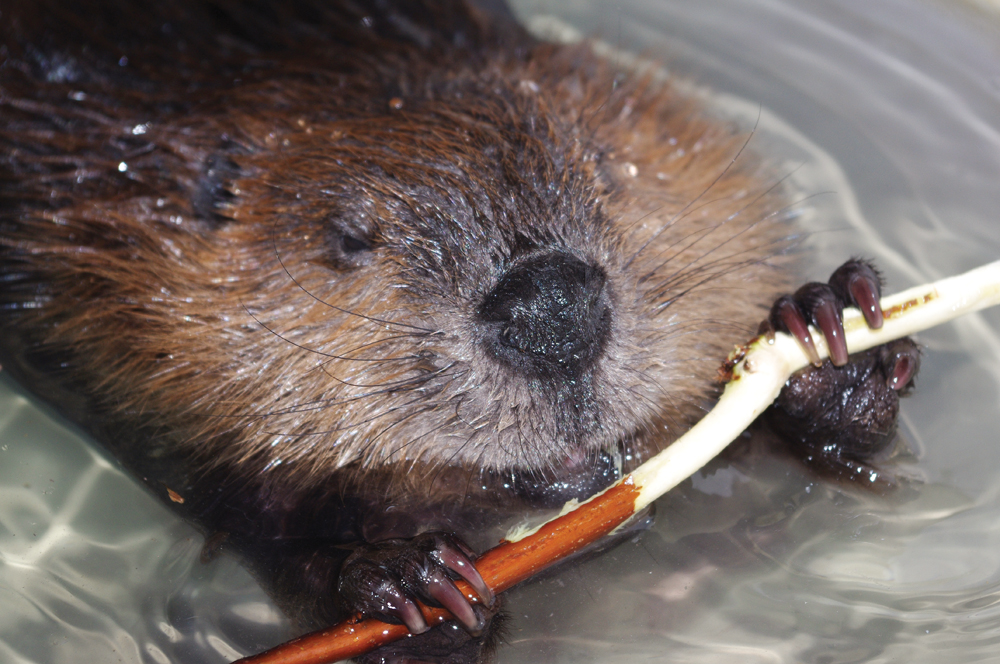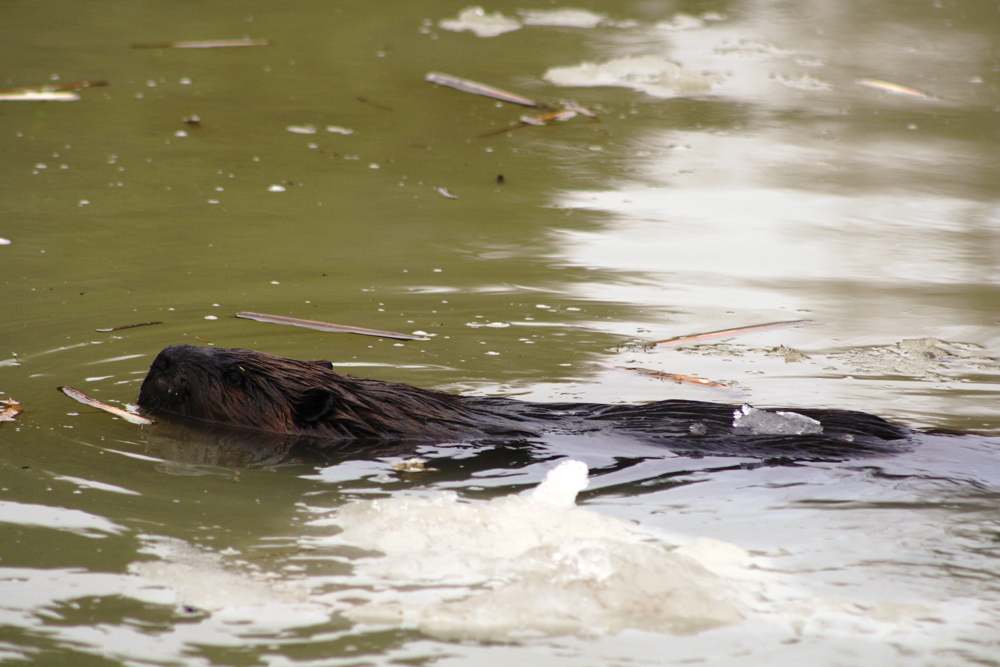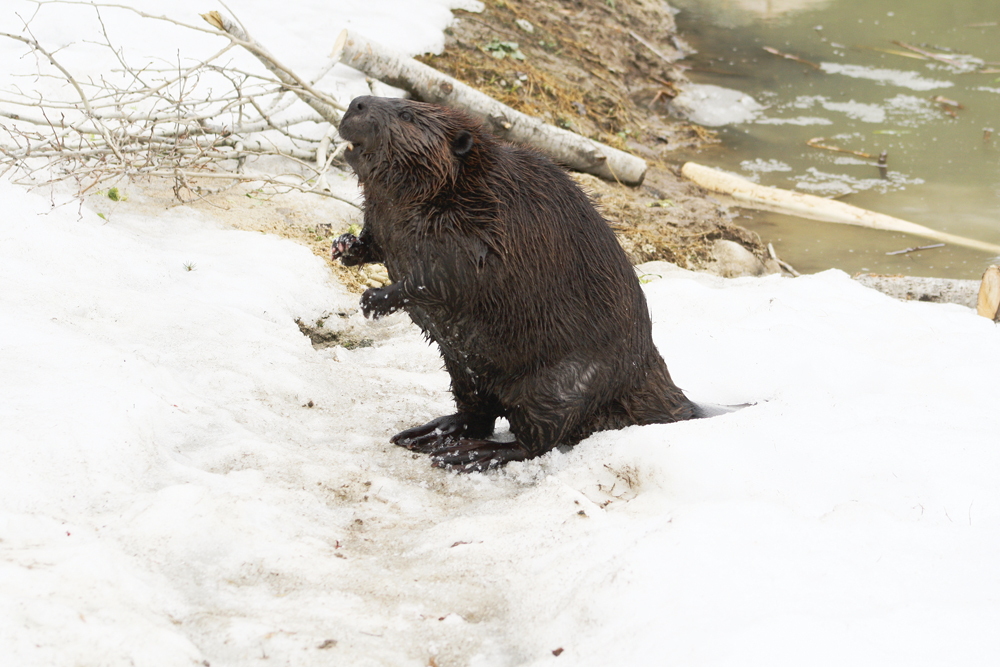I know it’s not Sunday but there’s plenty of good beaver news to go around. Starting with this article from Muskoka in Ontario, Canada. It is nicely written by Andrew Hind, who obviously has come to appreciate our flat-tailed friend.
Muskoka beavers build a healthier environment
Despite being a Canadian icon and a symbol of industriousness, many people view the beaver as a nuisance animal, blaming them for flooding and for damaging property through the felling of trees. Any derision towards the beaver, which generally is misplaced and based more upon myth than reality, masks the absolutely vital role beavers plays in creating a healthy environment – especially in areas with lots of wilderness and wildlife, like Muskoka.
Beavers spend much of their life building and maintaining dams that hold back the water and create the ponds in which they live. What most people fail to realize is that the beaver is not the only one to benefit from the habitat it creates.
The contributions made by beavers, perhaps nature’s most industrious animals, are more profound than most people realize. They are not the nuisance they are so often made out to be, but rather our partners in preserving the health of our planet Earth.
“The beaver is the largest rodent in North America and it has been commonly known as ‘nature’s-engineers’ because of what they do for the environment,” explains Muskoka naturalist Robin Tapley. “A beaver is the only other mammal besides man that alters its environment to suit its living requirements. However, in the case of the beaver, its contribution has a positive impact on the local flora and fauna and this greatly increases the biodiversity in an ever-shrinking natural world. Science has demonstrated that the result of a single dam has increased the number of birds, reptiles, mammals as large as deer and bears, and plant life in areas modified by beavers.”
Are you smiling yet? This is a ‘second cup of coffee’ kind of read and a great way to start the weekend. What I love about an article like this is the fact that you can tell right away it’s going to be good. And you are just curious how good?
Dave McLachlin, a biologist for Ducks Unlimited, enthusiastically agrees. “Beavers are what we call a ‘keystone species. Without them we would witness a collapse of the ecosystem. The wetlands that beavers help create are the most productive environment we have in Canada.”
Beaver ponds not only create biodiversity, but also help with local flood control, reduction of water turbidity, the filtration of herbicides and pesticides, and – eventually – the creation of fertile bottomland.
To understand the importance of the beaver pond to the local system we need to understand more about the life cycle of these ponds.
Some people view the appearance of a dam in a stream almost as a sign of rodent infestation, a nuisance that needs to be removed. Many even believe that the dam and the pond it creates will eventually lead to destructive flooding downstream. Tapley bristles at the notion that the appearance of a beaver dam is a blight on the environment.
 “A beaver dam is a complex structure designed specifically to slow the flow of water in a stream that results in creating a pond or wetland. Unfortunately, in the eyes of humans, flooded lands and fallen trees (specifically aspens, which is the tree of choice for beavers) appear to be an attack on the land. However, this is far from reality. The stumps grow new shoots which are a favoured food of moose and white tail deer, snags or dead standing trees become prime nesting locations for cavity nesters, including woodpeckers, wood ducks and mergansers, and the resulting wetlands offer increased habitat for insects, amphibians and reptiles, osprey, blue herons, mind and more – in fact, 85 per cent of all North American fauna rely on wetlands,” he explains.
“A beaver dam is a complex structure designed specifically to slow the flow of water in a stream that results in creating a pond or wetland. Unfortunately, in the eyes of humans, flooded lands and fallen trees (specifically aspens, which is the tree of choice for beavers) appear to be an attack on the land. However, this is far from reality. The stumps grow new shoots which are a favoured food of moose and white tail deer, snags or dead standing trees become prime nesting locations for cavity nesters, including woodpeckers, wood ducks and mergansers, and the resulting wetlands offer increased habitat for insects, amphibians and reptiles, osprey, blue herons, mind and more – in fact, 85 per cent of all North American fauna rely on wetlands,” he explains.
Beaver dams, he explains, do not cause flooding – just the opposite. They help control the flow of water in the surrounding area, facilitating flood control in times of high water and also help maintain a stable water table, making streams, ponds and marshes less vulnerable to drought.
Give it up for Dave from Ducks Unlimited! He clearly understand beaver benefits and the good they do. The article goes on to take a little detour from accuracy describing how the “male beavers disperse for long distances looking to start their own family”. (Which of course would never be possible for heterosexual beavers unless the females did it too.) But never mind that Dietland Muller Swarze wrote that beavers were very unusual in that the female disperers went farther than the males. (The only other animal where girls go farther is porcupines, which is just the kind of odd fact that stays in my brain.) Dave gets the important bits right on the money.
The sediment and debris captured within the pond settle to the bottom, making for better turbidity and allowing for a huge variety of protozoan and insect life. Turtles, fish, and bullfrogs and fish love these deeper waters. Larger snakes begin to arrive, taking advantage of the abundance of frogs. The grassy areas around the edges of the pond, meanwhile, make for ideal nesting habitat for waterfowl, such as ducks and Canada Geese. These same grassy areas are attractive to small rodents, which are in turn prey for marsh hawks and foxes. In just a short period of time an amazing diversity of wildlife calls the beaver pond home.
 The heightened wildlife activity centred on the beaver pond confirms its importance in biodiversity and maintenance of wetlands. In fact, Ducks Unlimited, which has a mandate to protect duck populations, recognizes the value of working with beavers to restore wetlands and the symbiotic relationship between healthy duck and beaver populations.
The heightened wildlife activity centred on the beaver pond confirms its importance in biodiversity and maintenance of wetlands. In fact, Ducks Unlimited, which has a mandate to protect duck populations, recognizes the value of working with beavers to restore wetlands and the symbiotic relationship between healthy duck and beaver populations.
“The habitat resulting from beaver activity is tremendous. Not only do so many species depend on it for food, shelter and breeding grounds but research has shown that bacteria attracted to a mature beaver pond helps remove nutrients (phosphates and nitrates) contained in the runoff from nearby farms, making for cleaner water. Herbicides and pesticides are also removed in a similar way,” notes McLachlin.
Beaver ponds are cyclical, however, and come and go. “Eventually the beavers move on and the dam breaks down, draining the water and leaving behind an extremely lush meadow and the cycle begins all over again,” explains Tapley.
And yet the one-time pond continues to pay rich dividends for the environment. The meadow – its soil consisting of muck that sat submerged on the pond’s bottom – is rich in nutrients and provides fertile ground for seed blown upon the winds. As a result, it doesn’t take long before there is enough lush vegetation for deer to begin grazing. Tree seedlings soon take hold. In about 15 more years a beaver meadow has formed. If left undisturbed, the area is likely to once again play host to beavers once trees have matured to about 10 centimetres in diameter.
Early Muskoka farmers appreciated the value of these rich bottomlands and cultivated them for raising crops. They reaped the bounty of more than a decade of labour by a colony of beavers.
So not only do beavers benefit all that wildlife when they’re actually in residence, when the pond silts up and is abandoned, the soil they leave behind is the rich loam farmers love best. And in between making ideal grow conditions and removing nitrogen beaver dams also prevent flooding. Are you sold yet? It’s wonderful to see an article like this appear out of nowhere. I usually hear something in the pipeline along the way, but this was a completely un-looked-for blessing. Go read the whole thing so Mr. Hind is reminded that folks care about beavers.
And late breaking I was just sent this by writer Ben Goldfarb who will be meeting with doctoral student Dan Kotter in Yellowstone to discuss his research. Here’s what the trail cam picked up recently, and check out Mr. Wolf at .41. Those beavers do not even trouble their pretty little (dry!) heads about him.
Plenty to do! And they’re just the critter to do it!




 Okay, I’ll give Mark a break. Maybe that was a misquote or taken out of context. Maybe you’re having an off day or your cat is in the vet. It’s mostly a wonderful article. And I’m still very happy about it. We all should be!
Okay, I’ll give Mark a break. Maybe that was a misquote or taken out of context. Maybe you’re having an off day or your cat is in the vet. It’s mostly a wonderful article. And I’m still very happy about it. We all should be! MARTINEZ — It started in 2007, when downtown Martinez citizens noticed Alhambra Creek was flowing slow, and that trees along the banks had been gnawed down to little points. The furry, buoyant culprits were elusive at first, but their first dam of sticks, leaves and mud near Marina Vista Avenue told the, er, tail.
MARTINEZ — It started in 2007, when downtown Martinez citizens noticed Alhambra Creek was flowing slow, and that trees along the banks had been gnawed down to little points. The furry, buoyant culprits were elusive at first, but their first dam of sticks, leaves and mud near Marina Vista Avenue told the, er, tail. “Who had even heard of beavers in town before?” said Heidi Perryman, president of the nonprofit Worth a Dam group. Someone she met literally walking down the street told her that beavers lived a few blocks from her Martinez home.
“Who had even heard of beavers in town before?” said Heidi Perryman, president of the nonprofit Worth a Dam group. Someone she met literally walking down the street told her that beavers lived a few blocks from her Martinez home. f people owner Luigi Daberdaku has met over the years. Most of them, he said, came downtown to find the beavers.
f people owner Luigi Daberdaku has met over the years. Most of them, he said, came downtown to find the beavers.


 But Perryman and others were overjoyed when, on March 5, a beaver was seen in the creek near downtown. It’s been seen at least twice since, and photographed at least once.
But Perryman and others were overjoyed when, on March 5, a beaver was seen in the creek near downtown. It’s been seen at least twice since, and photographed at least once.
 etts. They are a remarkable business I happen to love because they turn favorite literature into wearable art. Literally. The entire text of a beloved book becomes a shirt, card, poster, tote or scarf. Catcher in the Rye, Scarlet Letter, Jane Eyre, Hamlet, The Princess Bride, classic or contemporary.
etts. They are a remarkable business I happen to love because they turn favorite literature into wearable art. Literally. The entire text of a beloved book becomes a shirt, card, poster, tote or scarf. Catcher in the Rye, Scarlet Letter, Jane Eyre, Hamlet, The Princess Bride, classic or contemporary.




 PARRY SOUND SIDEROADS AND SHORELINES — Winter is the time of year when many wild animals living in the Parry Sound area have adapted to escape and wait out the heavy snowfalls and dropping temperatures. Bears hibernate in cosy dens, squirrels have built nests and stashed food away, and frogs have dug into the lake bottoms and drastically reduced their temperature. But the industrious beaver continues to be quite active during winter until the lakes freeze over completely, and even then this animal can be seen busily repairing any damage to its lodge or dam.
PARRY SOUND SIDEROADS AND SHORELINES — Winter is the time of year when many wild animals living in the Parry Sound area have adapted to escape and wait out the heavy snowfalls and dropping temperatures. Bears hibernate in cosy dens, squirrels have built nests and stashed food away, and frogs have dug into the lake bottoms and drastically reduced their temperature. But the industrious beaver continues to be quite active during winter until the lakes freeze over completely, and even then this animal can be seen busily repairing any damage to its lodge or dam. The resulting dam sets in motion an entire alteration to the ecosystem. Hence, beavers are considered a “keystone species” (one that plays a unique and crucial role in the way an ecosystem functions. Without keystone species, the ecosystem would be dramatically different or cease to exist altogether). The building of dams modifies and creates a dramatic change to the surrounding environment. The backwater flooding from the dam floods the lowland near the creek; trees die creating an opening in the forest canopy; aquatic plants and shrubs soon develop, making a favourable habitat for waterfowl, herons, moose, amphibians, fish, insects, muskrats, otters and a score of bird species. Their activity purifies water and prevents large-scale flooding.
The resulting dam sets in motion an entire alteration to the ecosystem. Hence, beavers are considered a “keystone species” (one that plays a unique and crucial role in the way an ecosystem functions. Without keystone species, the ecosystem would be dramatically different or cease to exist altogether). The building of dams modifies and creates a dramatic change to the surrounding environment. The backwater flooding from the dam floods the lowland near the creek; trees die creating an opening in the forest canopy; aquatic plants and shrubs soon develop, making a favourable habitat for waterfowl, herons, moose, amphibians, fish, insects, muskrats, otters and a score of bird species. Their activity purifies water and prevents large-scale flooding. A few years ago, the television program The Nature of Things featured a show entitled “The Beaver Whisperer” outlining the efforts of a few Canadians who have studied and/or worked with beavers, giving an in-depth account of the beaver. The Parry Sound area is home to many beavers and if you are lucky enough to see one around twilight, watch and observe the complex behaviour of this fascinating animal.
A few years ago, the television program The Nature of Things featured a show entitled “The Beaver Whisperer” outlining the efforts of a few Canadians who have studied and/or worked with beavers, giving an in-depth account of the beaver. The Parry Sound area is home to many beavers and if you are lucky enough to see one around twilight, watch and observe the complex behaviour of this fascinating animal. 




































